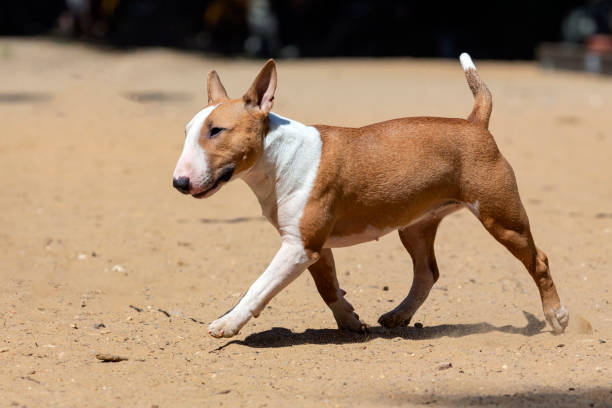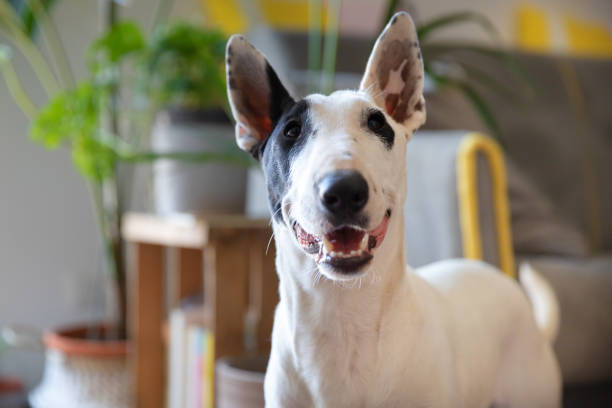Bull Terrier

Breed History:
The Bull Terrier originated in 19th-century England, developed by crossing Bulldogs with various terriers to create a strong, agile, and courageous fighting dog. Initially bred for blood sports such as bull-baiting and dog fighting, the breed evolved into a more companionable and refined dog.
James Hinks, an English breeder, played a significant role in creating the modern Bull Terrier by refining its appearance and temperament. He introduced the distinctive all-white variety, often referred to as the “White Cavalier.” Later, colored Bull Terriers were developed to expand the gene pool and offer variety. Today, the Bull Terrier is recognised for its muscular physique, egg-shaped head, and clownish yet loyal personality.
|
Gender |
Height |
Weight |
|
Male |
45–55 cm |
24–32 kg |
|
Female |
45–55 cm |
22–30 kg |
Size – Medium
Life Expectancy: 12–13 years

Breed Appearance:
The Bull Terrier is best known for its distinct head shape—an egg-shaped profile with a flat top and tapering muzzle. Its small, dark, triangular eyes and alert ears add to its unique and intense expression. The body is muscular and well-proportioned, with a strong, arched neck and a short, thick tail.
Its coat is short, dense, and glossy, coming in solid white or various colours like brindle, red, black, or fawn, sometimes with white markings. Despite its rugged appearance, the Bull Terrier moves with grace and agility, showcasing its athletic background.
Breed Type – Companion/Guard:
Originally a fighting dog, the Bull Terrier has evolved into a loyal and devoted family companion. It is protective and brave without being aggressive when properly socialised. It bonds deeply with its human family and is especially affectionate and playful, often earning the nickname “the clown of the dog world.”
This breed is alert and observant, making it a capable watchdog. However, it’s usually friendly with people when introduced properly. Its assertive nature may lead to dominance issues with other dogs, especially of the same sex, if not managed early.

Training:
The Bull Terrier is intelligent but independent, sometimes showing a stubborn streak. Training requires patience, consistency, and firm but gentle methods. Positive reinforcement, including treats and praise, works best to motivate this breed.
Early socialisation is critical to help the Bull Terrier adapt well to other dogs, people, and situations. Structured training sessions that are fun and engaging prevent boredom and help maintain the dog’s focus. Harsh or repetitive training methods may cause resistance or disinterest.
Health & Care:
Bull Terriers are generally healthy but are prone to a few breed-specific health concerns. These include:
-
Deafness, particularly in white Bull Terriers
-
Skin allergies and irritations
-
Hereditary nephritis (kidney disease)
-
Heart defects
-
Patellar luxation
Routine vet checkups, genetic screening, and a balanced diet are essential to keep them in optimal health. Early testing for hearing and kidney function is especially important in white Bull Terriers.

Living Conditions:
Bull Terriers adapt well to various living environments, including apartments, provided they receive adequate exercise and attention. They prefer being indoors with their family and may develop destructive behaviours if left alone for long periods.
They need mental stimulation and consistent routines to thrive. A securely fenced yard is ideal for off-leash play, but supervision is required to prevent escape or confrontations with other animals. Due to their short coat, they are moderately sensitive to extreme temperatures and should be protected in both hot and cold weather.
Exercise:
Bull Terriers are energetic and require regular physical and mental stimulation. Daily walks, interactive play, and games like tug-of-war or fetch help maintain their fitness and prevent boredom-related behaviour.
Without sufficient exercise, they may become restless or destructive. Activities that challenge their minds, such as agility or scent games, are also beneficial. It’s important to provide a structured outlet for their energy to keep them well-balanced and happy.
Grooming:
The Bull Terrier’s short coat is easy to care for, requiring only weekly brushing with a grooming mitt or soft-bristle brush to remove loose hair and keep the coat shiny. During seasonal shedding, more frequent brushing may be needed.
Bathe only when necessary, using a mild dog shampoo. Regular nail trimming, ear cleaning, and dental care are essential. White Bull Terriers may be more prone to sunburn and skin conditions, so sun exposure should be monitored, and appropriate skincare provided.

Advantages:
-
Distinctive appearance and playful personality
-
Loyal and deeply bonded to its family
-
Generally quiet and not prone to excessive barking
-
Adaptable to different living spaces
-
Low grooming needs due to short coat
-
Intelligent and responsive to positive training
Disadvantages:
-
Can be stubborn and independent-minded
-
May be aggressive toward other dogs without early socialisation
-
Prone to specific health issues, especially in white variants
-
Needs consistent training and mental stimulation
-
Requires supervision when off-leash or around small pets
-
Can be destructive if bored or left alone too long

